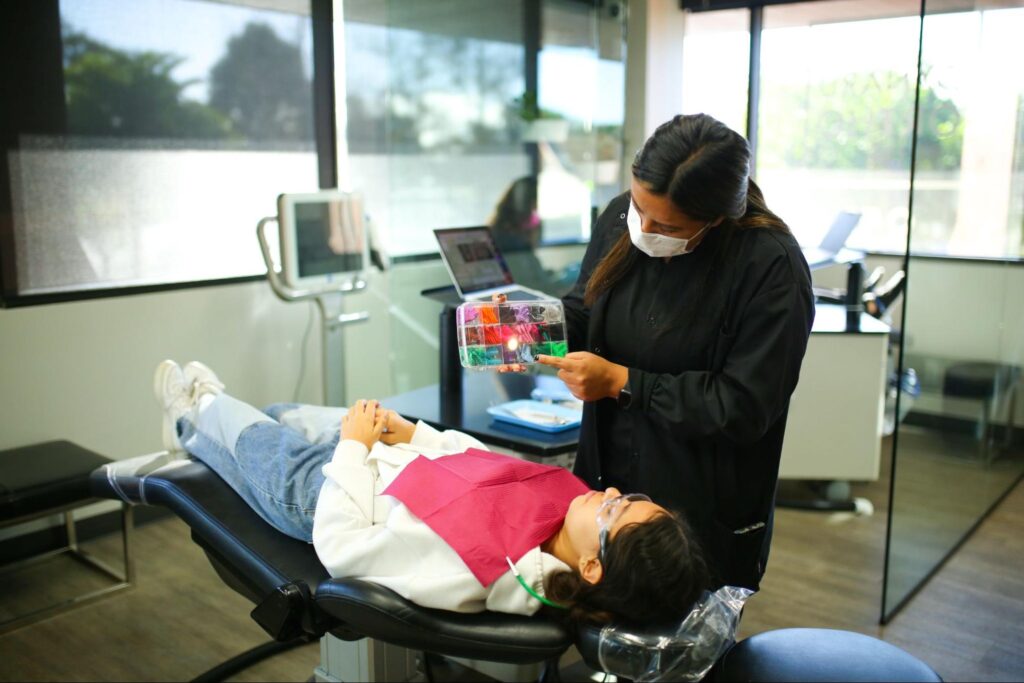People often underestimate just how different one person’s smile is from another. We all have unique teeth, and this shows in the process of making braces. Today, Dr. Jared Lee Orthodontics will explain in depth how customizable braces are. Let’s take a look!
Two Types of Braces
If we’re looking at braces and excluding clear aligners, there are two main options: clear and metal.
- Polycrystalline ceramic material forms the foundation of clear braces, offering a near-invisible appearance by closely resembling natural teeth. These braces not only offer practical solutions but also cater to aesthetic preferences. This can be an ideal choice for adult patients who are looking for a step below clear aligners but who still desire a subtle form of treatment.
- On the other hand, metal braces, with their durable metal brackets and traditional components, are a classic and highly efficient choice. They are often more cost-effective and are particularly suitable for children due to their resilience against physical activities and other potential factors that may pose a risk to the appliance.

Putting the Work In
Each patient presents unique factors that shape their personalized treatment plan. Here are some common considerations we take into account at Dr. Jared Lee Orthodontics:
- Age can play a significant role in determining the treatment approach and how teeth and jaws respond to orthodontic treatment. Children often exhibit more rapid responses due to their flexible tissues, while adults may present more complex issues requiring longer-term solutions.
- Severity of orthodontic issues is another crucial factor influencing treatment. It dictates the duration and complexity of the treatment plan, along with any supplementary measures that may be necessary.
- Anatomy variations, such as the size and shape of teeth, jaw positioning, and thickness of gingival tissue, also influence treatment planning and mechanics.
- Pre-existing conditions, like gum disease, temporomandibular joint (TMJ) disorders, or systemic health issues, may necessitate additional coordination and care between our office and other healthcare providers.
But even with variables like these, our general planning process will go like this for the majority of patients:
- Initial Consult: At your first appointment, you’ll meet with Dr. Lee for a comprehensive examination of your teeth, jaws, and overall oral health. We’ll discuss your treatment goals during this visit.
- Imaging: We will use x-rays and/or digital scans and impressions of your mouth and jaws to assess the alignment of your teeth and positioning of your roots. A traditional method is making dental impressions with a putty-like material, but this is shifting in a digital direction in many offices. One of the advantages of this technology is a high degree of precision throughout the treatment process.
- Treatment Planning: Based on our discussion and your medical history, Dr. Lee will create a personalized treatment plan for you, explaining it thoroughly.
- Fabrication: Once the plans are finalized, we’ll send the data to a dental lab where your braces will be custom-made to fit your teeth.
- Application: Your braces will be applied at a separate appointment. During this process:
- We’ll clean and dry your teeth to prepare for bonding.
- Special adhesive will be used to bond the brackets to the front of your teeth.
- Archwires will be threaded through the brackets and secured with small elastic bands.
- Adjustment Appointments: Throughout your treatment, you’ll have periodic appointments to make adjustments to the braces, such as changing the archwire or replacing ligatures.
- Monitoring Progress: We’ll see you regularly to monitor your progress and ensure your teeth are moving according to our plan. Periodic x-rays or scans may be taken to track movement and make adjustments to the treatment plan.
- Braces Removal: Once your teeth are in their new positions after alignment is complete, we’ll remove the braces. This involves carefully detaching the brackets and removing any remaining adhesive.
- Retention Phase: After braces removal, you may need to wear a retainer to maintain the new position of your teeth during the retention phase. We’ll provide instructions on wearing your retainer and how long it’s necessary.
- Follow-Up Appointments: We’ll schedule follow-up appointments to check the longevity and stability of your results after completing the treatment. If you ever have any new concerns, Dr. Lee will continue to be your primary resource for asking questions!

Keeping Braces Bespoke
As a team, one of our primary objectives is to provide personalized care and attention to each patient’s needs. Be assured that we are experts in our field, and we are eager to begin this orthodontic journey with you! You can reach our Oxnard or Santa Paula offices for more information!

